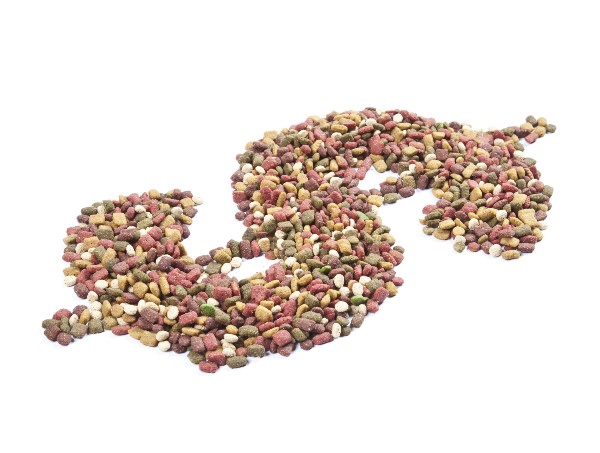Pet Food Spending Up 17.6% in 2023

DogFoodAdvisor is reader supported See how
Dog Food Advisor is 100% impartial and is never paid to promote any brand. But if you buy using links on this page, we may earn a referral fee.
Recently released data shows that 2023 saw U.S. pet parents significantly increase their spending on pet food, reaching a total of $45.5 billion — a 17.6% rise from the previous year. This surge, amounting to $6.81 billion more than in 2022, was highlighted in recent data released by the U.S. Bureau of Labor Statistics (BLS) and analyzed by John Gibbons, also known as the Pet Business Professor.
U.S. Pet Spending in 2023: Key Insights
The data reveals that households, or consumer units (CUs) as they like to call us, with pets across various income levels contributed to this rise, although spending patterns varied by demographic groups.
According to the BLS data, U.S. consumers spent at total of $117.6 billion on pet care overall in 2023, marking a 14.5% increase. Veterinary services experienced the largest growth within the pet care sector, surging by 20% to reach $35.66 billion. Pet supplies saw a more modest increase of 4.9%, while pet services grew by 8.5%.
Pet Food Spending Across Income Groups: A Shift in Trends
For the first time in recent years, lower-income households experienced the largest increases in pet food spending. This contrasts with previous trends where higher-income households dominated the growth.
Pet parents with annual incomes below $30,000 saw their spending jump by a staggering 45.7%, reaching an average of $230.58 per household, totaling $6.63 billion. This group represents 21.3% of all U.S. households.
Interestingly, households earning between $100,000 and $150,000 also showed a substantial rise, with spending increasing by 22.5%. These households, comprising 16.6% of U.S. households, spent an average of $399.09 per household, totaling $8.38 billion in 2023.
Middle-income groups also contributed to the spending growth, though at more moderate levels. households earning between $30,000 and $70,000 increased their pet food spending by 12.1%, spending an average of $291.97 per household, while those earning between $70,000 and $100,000 saw a smaller increase of 4.6%, with average spending at $316.88 per household.
The highest earners, with household incomes above $150,000, increased their spending by 7.1%, spending an average of $490.64, totaling $12.95 billion.
 Budget-Friendly Dog Foods”>
Budget-Friendly Dog Foods”>
Pet Food Spending by Age: Surprising Trends
Age group data revealed surprising patterns in pet food spending. Younger and older pet parents, particularly those aged 25-34 and over 75, reported the most significant spending increases.
CUs aged 25-34 spent 46.5% more on pet food in 2023, while those over 75 increased spending by 53.2%. Despite these substantial hikes, these age groups represent smaller proportions of total U.S. households, at 15.7% and 11.4%, respectively.
CUs led by individuals under 25 also saw a large increase, with spending up 37%, although this group represents only 4.5% of U.S. households. More typical increases occurred among households aged 35-44, which spent 16.6% more on pet food, and those aged 65-74, which saw a 31.4% rise.
Conversely, some age groups reduced their pet food spending. Households aged 45-54 and 55-64 cut their spending by 4.9% and 2.2%, respectively, despite representing 16.9% and 17.8% of U.S. households.
In terms of total spending, CUs aged 65-74 led the pack with an average of $413.49 per household, totaling $9 billion. households aged 35-44 followed closely, spending an average of $352.55, for a total of $8.43 billion.
The Role of Inflation in Pet Food Spending
While these spending increases might appear promising for the pet food industry, inflation played a significant role in the rising costs. Pet food inflation remained high throughout 2023, with prices still nearly 22% higher than at the end of 2021 and around 23% more than pre-pandemic levels in 2019. As a result, a portion of the spending increase can be attributed to inflation rather than purely higher consumption or premium product choices.
Despite the inflationary pressures, the overall increase in pet food spending highlights the resilience of the pet care market and the love people have for their pets, prioritizing their animals’ needs even amid rising costs.
Final word
The Dog Food Advisor does not accept money, gifts, samples or other incentives in exchange for special consideration in preparing our reviews.
However, we do receive a referral fee from online retailers (like Chewy or Amazon) and from sellers of perishable pet food when readers click over to their websites from ours. This helps cover the cost of operation of our free blog. Thanks for your support.
For more information, please visit our Disclaimer and Disclosure page.



